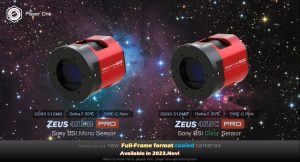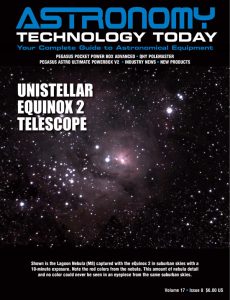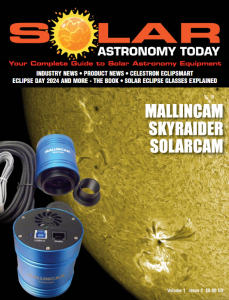Two new Player One ZEUS 455 PRO cameras have been released, the ZEUS 455C PRO and ZEUS 455M PRO. Both are cooled cameras and are designed for DSO imaging.
The Player One ZEUS 455 PRO cameras are full frame cameras that utilize the Sony IMX294 4/3″ format color sensor. The 4.63um pixel size accommodates a well depth of 65.8Ke with a total of 11.7MP (the resolution is 4144*2824) and the diagonal is 23.2mm.
 Both new cameras offer a rear adjustable tilt plate which offers 4-point adjustment and removes the need to adjust tilt from the front of the camera. The 512MB DDR3 cache helps stabilize and secure data transmission helping to avoid frame dropping and greatly reducing readout noise. The cameras offer a Two Stage TEC Cooling unit designed to remove the heat allowing the camera to reach a Delta-T of over 35℃.
Both new cameras offer a rear adjustable tilt plate which offers 4-point adjustment and removes the need to adjust tilt from the front of the camera. The 512MB DDR3 cache helps stabilize and secure data transmission helping to avoid frame dropping and greatly reducing readout noise. The cameras offer a Two Stage TEC Cooling unit designed to remove the heat allowing the camera to reach a Delta-T of over 35℃.
The Player One ZEUS 455 PRO cameras’ specifications include:
– Sensor: New SONY IMX455AQK-K full-frame CMOS (color)
– Diagonal: 44.3mm
– Total Pixels: 61 Mega Pixels
– Max Resolution: 9576×6388
– Pixel Size: 3.76μm
– Chip Size: 36mm×24mm
– Shutter: Rolling shutter
– Exposure Range: 32μs-2000s
– Readout Noise: 4.2-1.27e
– Full Well: 71.6k e
– QE Peak: ≈80%
– ADC: 16 bit
– Cooling: 2 stage TEC
– Cooler Power Consumption: 12V – 3A Max
– Delta T: 35℃ ± 2℃ (below ambient)
– Working Temperature: -10°C—60°C
– Working Relative Humidity: 0%—80%
– Protective Window: D55*2MM AR Plus (Anti Reflection) Multi-Layer Coating
– Data Port: Type-C USB3.0/USB2.0
– Adapter: M54X0.75, 2″
– Back Focal Length: 17.5mm, 12.5mm (without sensor tilt plate)
– Diameter: 90mm
– Weight: 650g
You can learn more about the Player One ZEUS 455 PRO cameras here.

 And to make it easier for you to get the most extensive news, articles and reviews that are only available in the magazine pages of Astronomy Technology Today, we are offering a 1-year magazine subscription for only $6! Or, for an even better deal, we are offering 2 years for only $9. Click here to get these deals which only will be available for a very limited time. You can also check out a free sample issue here.
And to make it easier for you to get the most extensive news, articles and reviews that are only available in the magazine pages of Astronomy Technology Today, we are offering a 1-year magazine subscription for only $6! Or, for an even better deal, we are offering 2 years for only $9. Click here to get these deals which only will be available for a very limited time. You can also check out a free sample issue here.
The Sun is more active than it’s been in years and if that’s not enough, we have the upcoming Total Solar Eclipse on April 8, 2024! If you’d like to learn more about the technology behind solar observing, solar imaging and more, you can check out our new monthly magazine – Solar Astronomy Today. It’s free to read, no subscription needed and available here. And if you are preparing for the upcoming eclipses and want to know your equipment options from solar glasses to the most out of this world solar viewing and imaging options, check out our free publication – The Definitive Guide to Viewing and Imaging the Sun – simply click here and enjoy reading!

